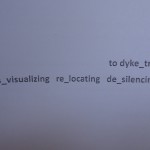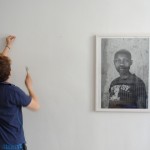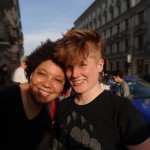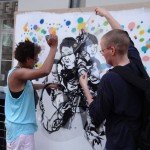miscellaneous
interdependencies
discriminations are always complex. there are no simple, monolithic discriminations which can be added up in politics and analysis or which are arbitrary or interchangeable. genderistic discrimination for example, is always also constituted by racism_ableism. genderism is different for Black, PoC or white trans_x_ing persons. it is interpreted differently, experienced differently, ascribed differently and it materializes in different ways.
maybe the concepts genderism/sexism as such are already racist because they imply that racism_sexism are separable. this is not and has not been the case for Black women and WoC. to introduce and apply sexism/genderism as monolithic concepts is maybe a powerful presupposition for introducing a concept like intersectionality – and it is thereby manifesting a universalist white ableist position which can explain everything.
in a societal situation in which power relation are categorized as separable, interdependencies have to be taken into account in any case. starting from this presupposition genderism and racism and ableism are inseparably interwoven and present all the time. the idea of the existence of genderism beyond racism and ableism is creating a white ableist norm as universalist. therefore, every analysis of genderism and every politics against genderism needs always be differentiated referring to other, only analytically separable discriminations as racism and ableism as well as migratism and classism.
not to perceive interdependencies simplifies discriminations in ways which make them more difficult to work against: for example when trans politics are fighting for the right to have a transgender-category in a german passport: illegalized trans-persons within germany and their discriminations are thus excluded from this politics.
inspiring_empowering reading: combahee river collective (1981): „a Black feminist statement“. in cherrié m. moraga and gloria anzaldúa (hg.): this bridge called my back. writings by radical women of color. new york, 210-218.
aesthetics
aesthetics, being used in a conventional way, is the hegemonic understanding of something “beautiful brilliant artistically impressing important expressive literary relevant” – or the opposite of all this
how could any aesthetic evaluation be beyond political impact and significance?
to put it more radically: how can something racist be beautiful?
in discussions on and about racist linguistic actions white people are claiming for themselves to be experts for everything. they say that certain uses of terms or texts are literarily and aesthetically important. this point is still made even if Black people and PoC demand not to use certain terms anymore because they are racist. it is argued that single terms cannot simply be changed – they are evaluated as historically aesthetic and hence untouchable. what does that mean for what aesthetics is!?
it seems as if beauty and aesthetics existed as values and imaginations beyond concrete political effects, political actions, concrete situations, discriminations – or even beyond statements of discriminated people about their usage. who is still evaluating something as beautiful if it is discriminating!? does that mean that beauty is part of the discriminating regime?
if a white person is using a (however historicized) term that discriminates Black persons, in what way could that ever be “aesthetic”? what kind of aesthetics would that be? aesthetics of racism?
how is it possible that feminist language changes – x-forms, underscore forms – are interpreted as non-aesthetical, if, at the same time, it is so evident that these are forms chosen by genderistically discriminated people? whose understandings of aesthetics are thus being normalized and whose are being evaluated as affected_emotional_extreme? are aesthetics privileged and discriminating normalizations?
aesthetics in a de_politicizing usage, and decontextualized from the presence and effect and power of structural discriminations is thus itself discriminatory, structural, artistically playing down and presented as coming from an decontextualized other sphere. such an understanding of aesthetics constitutes a politically structural discriminatory understanding of art. xart splitta does not share this understanding but tries to challenge it.
inspiring readings: send us your ideas and references to texts you know!
critique
critique is feeling alive
being criticized is being noticed
is willing to deal with me and my positions_statements_actings
critique is being open for contact
is wishing communication
and expressing differences
differences as a positive resource
critique is productive
critique is important to deal with each other, to learn from each other, to communicate and work with each other
critique for us starts with acknowledging of what another person thinks_does_means
critique is respectfully accepting differences – if it is not genderist_racist_ableist_classist_migratist – then critique can be severe and clear and strong and loud – because what was before was not respectful
we are trying to realize critique as form of acting
through asking open questions, asking further questions, listening, framing own positions and ideas, through avoiding universalisms, avoiding generalizing evaluations, avoiding degradations and hierarchizations
we, xart splitta, perceive critique as coming closer to one another, moving conjoined – in contact and in difference






















